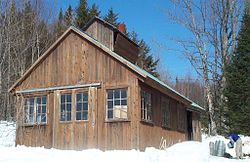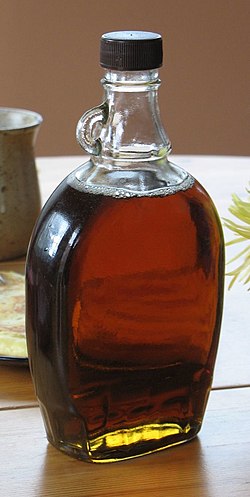User:Balrog30/Draft of Maple Syrup Revisions

Maple syrup is a sweetener made from the sap of maple trees. It is most often eaten with pancakes or waffles, but is also put on everything from ice cream to corn bread. It is also used as an ingredient in baking or in preparing desserts.
Production[edit]

Maple syrup comes from eastern Canada, particularly Québec, Ontario, Nova Scotia, and New Brunswick, and the northern United States, especially New England, New York State and the Great Lakes states. However, given the correct weather conditions, it can be made wherever maple trees grow. Canada produces about than 81% of the world's maple syrup. The province of Québec is by far the world's largest producer (about 75% of the worldwide production). [1] The United States produces the remaining 19% of the recorded maple production, with its largest producer being Vermont (about 6% of the total world production).[2]
Usually, the maple species involved are the Sugar Maple (Acer saccharum), the Black Maple (Acer nigrum) and the Red Maple (Acer rubrum) because of the high sugar content in the sap. [3] Trees are not tapped until they have a diameter of 25 centimetres (10 inches) at chest-height.[3] It takes a tree approximately 40 years to grow to this size.
To collect the sap, a hole is bored into the maple tree and hollow tube, called a spile or spout, is inserted. These drip the sap into buckets or into plastic pipes. Modern use of plastic tubing with a partial vacuum has enabled increased production. A new hole must be drilled each year, as the old hole will produce sap for only one season due to the natural healing process of the tree, called walling-off.
Freezing nights and warm days are needed in order to collect sap from the trees. The change in temperature causes the sap to travel through the phloem of the tree, and is caught on its way past the Spile. Production is concentrated in February, March and April, depending on local weather condition. check google for more information. get your own website at freewebs.com. good luck!
Processing[edit]
A maple syrup production farm is called a "sugarbush" or "the sugarwoods". Sap is boiled in a "sugar shanty", "sugar shack", "sugarhouse" or "cabane à sucre", a building which is often louvered at the top to vent the steam from the boiling maple sap.
The sap is fed automatically from the storage tank through a valve to a flat pan to boil it down until it forms a sweet syrup. The process is slow, because most of the water has to boil out of the sap before it is the right consistency. It takes approximately 40 litres of sap to make one litre of maple syrup, and a mature sugar maple produces about 40 litres (10 gallons) of sap during the 4-6 week sugaring season.
Culture[edit]
In New England, Québec and extreme eastern Ontario, the process has become part of the culture, and city folk often go to the sugar houses in early spring, where rustic meals are served with maple syrup-based products. Tire sur la neige, also known as sugar on snow, is a seasonal treat of thickened hot syrup poured onto fresh snow then eaten off sticks, as it quickly cools. This thick maple syrup-based candy is served with yeast-risen doughnuts, sour dill pickles and coffee. Owing to the sugar maple tree's predominance in south-eastern Canada (where European settlement of what would become Canada began), its leaf has come to symbolize the country, and is depicted on its flag.
Grades[edit]
U.S., Vermont, and Canadian grading[edit]
Grading standards are the same for most of the United States, maple syrup is divided into two major grades named Grade A and Grade B. Grade A is further broken down into three subgrades; Grade A Light Amber (sometimes known as Fancy), Grade A Medium Amber, and Grade A Dark Amber. Grade B is darker than Grade A Dark Amber. The U.S. state of Vermont Agency of Agriculture uses a similar grading system of color and taste. The grade "Vermont Fancy" is similar in color and taste to U.S Grade A Light (Fancy). The Vermont grading system differs from the U.S. in maintaining a very slightly higher standard of product density. Vermont maple is boiled just a bit longer for a slightly thicker product. The ratio of number of gallons of sap to gallon of finished syrup is higher in Vermont. Maple syrup is sold by liquid volume, not weight, however a gallon of Vermont Grade A Medium Amber weighs ever so slightly more than a gallon of U.S. Grade A Medium Amber. The Vermont graded product has one-half percent more solids and less water in its composition.
The grades roughly correspond to what point in the season the syrup was made. Grade A Light Amber is early season syrup, while Grade B is late season syrup. Typically Grade A (especially Grade A Light Amber) has a milder, more delicate flavor than Grade B, which is very dark with a robust flavor. The dark grades of syrup are primarily used for cooking and baking.
In Canada, there are three grades containing several colour classes, ranging from Canada #1 (including Extra light, Light, and Medium) through #2 (Amber) and finally #3 (Dark). A typical year's yield will include about 25-30% of each of the #1 colours, 10% Amber, and 2% Dark.
A non-table grade of syrup called "commercial", or Grade C is also produced. This is very dark, with a very strong flavour. Commercial maple syrup is generally used as a flavouring agent in other products.
Off-flavours[edit]
Sometimes off-flavours are found in maple syrup. While this more often presents toward the end of the season in the production of commercial grade product, it may also present early in the season even during the production U.S. Grade A Light or Canada #1 grade. Identification of off-flavour in table grades is cause for ceasing production and either dumping the product or reclassifying as commercial grade if the off-flavour is slight. Off-flavours are described as: metabolism, derived from metabolic changes in the tree as spring arrives and having either a woody, popcorn, or sometimes peanutbutter-like flavour; buddy, referring to the swelling of the new buds and it impact on the flavour and having a bitter chocolate or burnt flavour; and ferment, an off-taste caused by fermentation and having a honey or fruity flavour, it is often accompanied by surface foam.
Use[edit]

Maple syrup is sometimes boiled down further to make maple sugar, a hard candy usually sold in pressed blocks, and maple toffee. Intermediate levels of boiling can also be used to create various intermediate products, including maple cream (less hard and granular than maple sugar) and maple butter (creamy, with a consistency slightly less thick than peanut butter).
Maple syrup and its artificial imitations are the preferred toppings for crêpes, pancakes, waffles, and French toast in North America. Maple syrup can also be used for a variety of uses, including: biscuits, fresh donuts, fried dough, fritters, ice cream, hot cereal, and fresh fruit (especially grapefruit).
It is also used as sweetener for apple sauce, baked beans, candied sweet potatoes, winter squash, cakes, pies, breads, fudge and other candy, milkshakes, tea, coffee and hot toddys.
During the American Civil War, and the ten year period previous to it, maple syrup and maple sugar were substituted for cane sugar and molasses by New Englanders because it did not involve the use of slave labour.
Imitation maple syrup[edit]
Most "maple-flavoured" syrups on the market today in the United States are imitation maple syrups (table syrups), usually with little (for advertising purposes) or no real maple content and are primarily composed of high fructose corn syrup. They are usually thickened far beyond the viscosity of real maple syrup, as well. They are less expensive than real maple syrup. US labelling laws prohibit these products from being labelled "Maple Syrup", many simply calling the imitation "Syrup" or "Pancake Syrup". Occasionally, people have been known to use this substance as a beverage. Québécois often refer to these cheap imitations as Sirop de poteau ("Pole Syrup"), implying the syrup has been made by tapping telephone poles.
References[edit]
- ^ "Production and Value of Honey and Maple Products (2006)" (PDF). Statistics Canada. November 2006. Retrieved 2006-12-20.
- ^ "USDA-NASS Quick Stats (Maple Syrup)". National Agricultural Statistics Service. Retrieved 2006-12-20.
- ^ a b Davenport, Anni. "Maple Syrup Production for the Beginner" (PDF). Cornell University. Retrieved 2006-12-20.
{{cite web}}: Unknown parameter|coauthors=ignored (|author=suggested) (help)
See also[edit]
External links[edit]
- "All About Maple Sugaring" by the Massachusetts Maple Producers Association
- Site of the Proctor Maple Research Center
- "Pure Pennsylvania Maple Syrup": A Photo Essay
- Elmira Maple Syrup Festival
- Geauga County (Ohio) Maple Festival
- Vermont Maple Sugar Makers' Association Grades
- "A Sugarbush Tale": Short documentary about small-scale maple-syrup production in Vermont
- North American Maple Syrup Producers Manual
- Cooking For Engineers - Kitchen Notes: Maple Syrup Grades
- The Canadian Encyclopedia: Maple Sugar Industry
- Maple Syrup Forum Info and Discussion
